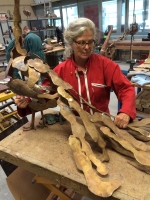Biografy
Jozephine Wortelboer, 1954
Education
ABK minerva, Groningen, 1979
Bronze in motion
There is certainly something special about the bird images that sculptress Jozephine Wortelboer depicts. The bronze sculpture has a stylized shape and is robust; nothing is incorporated that does not add something to the sculpture. Nonetheless, her birds are clearly identifiable, soft and in motion. Watch the kingfishers playing, listen to the blackbirds sing and feel the soft plumage of the hoopoe.
Birds are one of the artist’s favourite subjects. Some are placed high on poles, others low on a stone. “Birds appeal to me. Maybe it’s because of the proportions between the downy broad body and skinny legs. There is already a natural kind of tension and I’m always in search of tension. I play with space in my sculptures. I also create human figures, some of which I call ‘strange birds’ They are pluming their feathers just like my birds, showing their colours similar to those in a courtship display”.

Jozephine can work undisturbed on a creation for days on end in her studio. The interior looks sturdy and masculine: lots of heavy tools and lying on a shelf is a safety-helmet. “There are many different aspects to sculpting. After a sculpture has been cast it has to be reworked and then given a colour, which is known as a patine. This is accomplished using a burner and acid. My coloured patine has become my speciality; it gives my sculptures a lively expression”
There are tongs, that you would normally only find on a dentists utensils dish, on workbenches all over the studio.
“I compose my sculptures from wax. I start by making a palisade on which I construct the bird. I then cast plates of wax which I form into whatever shape suggests itself to me. Every sculpture has a different texture, because every bird is different. I rip the large plates of wax into smaller parts which I then compose into an image. It is very precise work. During the moulding process I can see if the tension is there or not. I just keep on going until I find that tension.
The biggest challenge lies in the fragility of the work. The image is ultimately cast in bronze which is a solid, heavy material. Nevertheless, my birds look light because I use inner space, amongst other things, in my work. The more open space there is, the easier it is for more people to give their own interpretation to the sculpture. This kind of open work requires a good casting technique. It is possible to cast a sculpture in parts and then weld the pieces together, but I don’t want to do that. My sculptures are at present usually cast in one piece”.
Discover and search
Jozephine knew from an early age that she wanted to be a sculptress. “No idea where that came from, I had hardly ever seen a sculpture and nobody in my family was interested. It was definitely something that came from inside me. This powerful idea was responsible for getting me through the art academy in Groningen. There, I learned how to observe and developed a good attitude towards work. As an artist you have to discover things for yourself and continually figure things out. I am proud of what I have achieved. You have to find your own way and persevere, even though it gets really tough sometimes. That’s what I learned at the academy. I have never lacked inspiration. Ideas have to simmer for a while before I actually make a start. Sometimes I am inspired by a particular bird for a while. I have crafted the ostrich in all its diversity: solo and in a group. They are beautiful, elegant animals with an extremely large torso on very long, narrow legs. I try to capture this playful elegance in my sculptures.
Over the years I have left out more and more in my sculptures. That openness benefits the character of birds. They are light and can fly away at any moment. My birds do well outside. The material is suited to outdoors, it turns slightly darker and worn being outside. I try to achieve the essence”.
Text: Margriet de Groot
